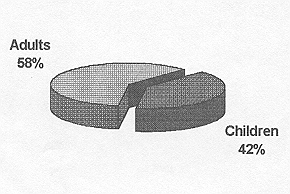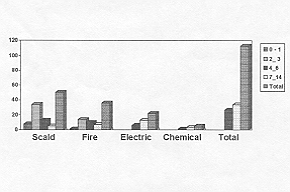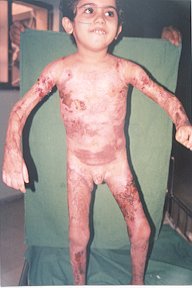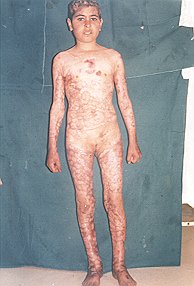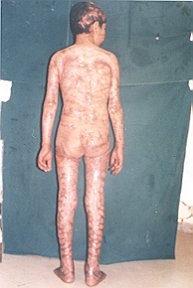| Annals of Burns and Fire Disasters - vol. XI - n. 1 - March 1998
COMPLICATIONS OF BURNS IN CHILDREN - A STUDY OF 266 SEVERELY BURNED CHILDREN ADMITTED TO A BURNS CENTRE Shahin A., Shadata G., Franka M.R., Abusetta A., Brogouski A., Ezzaidi M.M. Burn and Plastic Surgery Centre, Tripoli, Libya SUMMARY. This study covers 113 children aged 0-14 yr divided into four age groups: 0-1 yr, 2-3 yr, 4-6 yr and 7-14 yr admitted to a burn ICU in Libya in the period 1995-97. The criteria for admission to the ICU were extensive burns, inhalation injury, burns with complications, and burns with other systemic problems. For extensive burns, antacids and H2 receptor blocking agents were administered. Tangential excision is our method of choice, but we perform fascial excision in deep third-degree flame burns. Scalding was the main cause of burns, followed by flame. Out of the 113 children admitted, sixteen (14%) died. The main cause of mortality was septicaernia, prevalently due to Pseudomonas. Introduction Burns are the most devastating of
injuries and burn patients may suffer from their complications for the rest of their
lives. In spite of recent developments in burn care we still see high mortality and
significant morbidity in terms of burn complications.
The burn ICU has nine beds, three
isolation rooms, and two large rooms with three beds. Each room contains an airfluidized
bed, a general bed, a bath set, and Striker beds. There is one operating theatre for the
ICU only and one dressing-room. All beds are equipped with adequate monitoring facilities.
The ward is completely isolated, and visitors are not admitted. The criteria for admission
to the ICU are extensive burns, inhalation injury burns with complications, and burns with
other systemic problems.
Oral antibiotics for disinfection of the gastrointestinal tract The local treatment of the burn wound
depends on the area involved (open or closed method). We used the open method used for the
face, scalp and perineum, while the closed method involved the use of flammazine
SulfamyIon betadine solution.
The percentage of burns in the different age groups is shown in Table II.
Tables III and IV show respectively the periods of ICU stay in relation to percentage burn and age group.
Out of the 113 children admitted to the ICU, sixteen died, corresponding to a mortality rate of 14%. Of these sixteen children, two with extensive flame burns sustained in a closed space died within 48 It. One nine-month-old child 17% TBSA burns suffering from congenital heart disease (VSD) died on day 5 post-burn owing to cardiac failure. One year-old child with 21% TBSA burns died after seven days because of DIC. Two children died after 30 days when their wounds were already covered, one (two years old, suffering from 50% TBSA burns) owing to RDS, and the other (six years old, 54% TBSA) as a result of massive gastrointestinal bleeding. The remainder of the patients died in the second to third week. The main causes of mortality were septicaemia, mainly due to Pseudomonas, RDS and ARR
The commonest cause of burns in children is scalds due to hot fluids, mainly water and tea. Since the early 1990s we have performed early surgical excision in such children. We sometimes initiate surgery in the resuscitation phase, and in the last two years this has had positive results on the mortality rate, duration of hospital stay, and also morbidity.
We have treated successfully many severely burned children, one with 76% TBSA burns and many others with more than 50%. These children require very aggressive early nutritional support. Our study indicated that for burned children proper early resuscitation is essential. Usually, we receive patients from other hospitals, with over- or under-resuscitation, who develop a large number of complications. This emphasizes the importance of training of physicians in the treatment of burned children, especially if they present severe traumas.
RESUME. Cette étude considère 113 enfants brûlés divisés en quatre groupes: 0-1 ans, 2-3 ans, 4-6 ans et 7-14 ans, hospitalisés dans un centre de soins intensifs en Libye pendant les armés 1995-97. Les critères pour l'hospitalisation étaient les brûlures étendues, les lésions d'inhalation, les brûlures accompagnées par des complications et d'autres problèmes systémiques. Dans les cas des brûlures étendues, les antiacides et les agents bloqueurs des récepteurs H2 ont été administrés. Nous préférons la méthode de l'excision tangentielle, mais nous exécutons l'excision de la fascia dans les brûlures profondes de troisième degré. La cause principale des brûlures était l'ébouillantement, suivie par les flammes. Des 113 enfants hospitalisés, seize sont morts (14%). Les causes principales de la mortalité étaient la septicémie, pour la plupart causée par le Pseudomonas. BIBLIOGRAPHY
|
